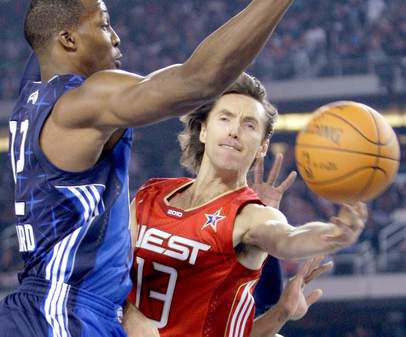NBA’s 30-something players have learned that they can age gracefully
Published 4:00 am Monday, February 15, 2010

- West All-Star Steve Nash passes the ball against East All-Star Dwight Howard during the NBA All-Star game Sunday in Arlington, Texas.
DALLAS — Take a look at the players who are playing Sunday in the All-Star Game and there are tangible ways you can see their age without looking at their date of birth.
Some of them, you can count the rings on their fingers to calculate the years.
For others, you’d need to cut them open to find any rings, which would be as plentiful as any giant redwood tree.
Either way, in the NBA, old is in.
Steve Nash turned 36 last week. He looks older than that, battle scars mounting every time he takes another smack to the mouth resulting in more blood and stitches. But he was voted in as a starter for the All-Star Game at Cowboys Stadium.
Tim Duncan is 33 and continues to anchor the Spurs, whose consistency for more than a decade embodies that of their tireless leader.
Dirk Nowitzki is in his 12th season and is 31 years old.
Kevin Garnett seems like he’s been around since Jerry West was in his prime. He’s 33 and has missed considerable time of late with injuries but remains the heart and soul of the Celtics.
For the most part, these guys don’t need a walker to get around on the court. They have maintained remarkable health and staying power to pile up more All-Star appearances than anybody could count.
But since you asked, the eight 30-somethings in Sunday’s game will have a combined 77 All-Star Game appearances under their belts.
And this doesn’t include some of the grizzled greats like Ray Allen, Jason Kidd, Ben Wallace, Antawn Jamison, Grant Hill, Rip Hamilton and the like who still produce at a very high level well into their 30s.
Steve Kerr, the longtime shooter extraordinaire who now runs Phoenix’s basketball operations, believes modern advances in health care are a big part of the ability of older players to extend their careers.
“When I came into the league in ‘88, I was given a membership pass to a club, and they said if you want to work out, here you go,” Kerr says. “That was it. We didn’t have a strength and conditioning coach.
“Now, we’ve got two full-time guys, we have a physical therapist, a program that has revived guys’ careers. I think you take better care of yourself and there are better things out there in terms of working out and preparing your body, mentally and physically.”
There’s a pride factor involved for the older generation. Kidd, who will turn 37 next month, is a 10-time All-Star, and replaced the injured Kobe Bryant on the roster. He was playing in the NBA when Mavericks rookie guard Roddy Beaubois was 6 years old.
“Look at Brett Favre or Lance Armstrong — those guys give us hope that we can play at a high level at 30-something,” Kidd says. “You look at our league, and your career doesn’t end if you’re 35.”
Granted, a lot of those NBA graybeards don’t have championship rings. But many of them do. Still others have legitimate chances to win one before they are done.
Nash is arguably the poster child for beating Father Time. Many people — and Mavs owner Mark Cuban led the chorus — predicted Nash’s body would break down not long after he bolted to the Suns in free agency in 2004.
And yet, he’s won two MVPs and is in the midst of an outstanding season.
“I think it’s all sports,” Nash said of athletes trending toward AARP membership. “And I think it’s because we know a lot more about the body now. We know a lot more about preparing and recovering and longevity.
“I think it’s just the evolution of sports — diet, training, recovery, sleep. We’re more conscious of all that to retain your athleticism and continue to play at ages that previously weren’t as friendly for professional athletes.
“Baseball players are All-Stars in their 40s. We’re just doing things now that we didn’t do 10, 20, 25 years ago.”
Garnett, Shaquille O’Neal, Paul Pierce, Bryant (though he won’t play) and Duncan all have won championships and are on the north side of 30.
Others are still searching. And they are grateful that their bodies have held up to give them as many chances as possible. The key, Kidd says, is surviving the inevitable tough spots in the long regular-season grind. Once the playoffs hit, there is ample rest time for creaky veterans.
“The biggest thing is a season of back-to-backs and four in five nights, but if you get through that, you feel like you have the advantage of knowledge going into the playoffs and that experience is hopefully what we’ll have,” Kidd said. “I feel great and sometimes if you hang around young guys, it keeps you young.
“Hey, a lot of golfers are playing well at 40 and even 50.”
No argument there. But the NBA isn’t golf. Even Kidd and the new-old generation will have to draw the line well before 50.
Right?






